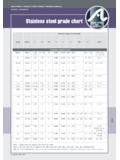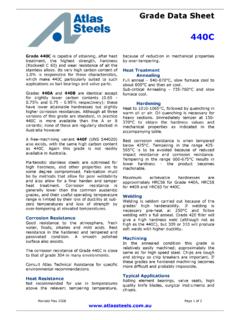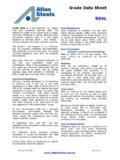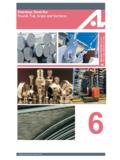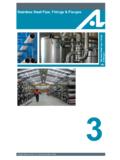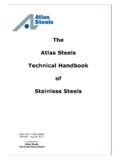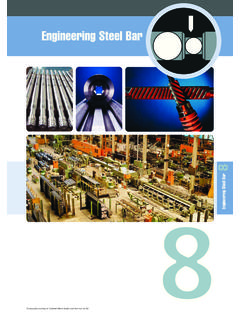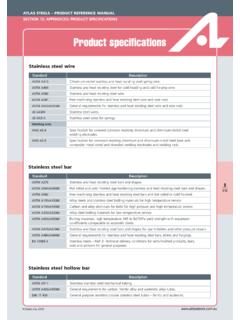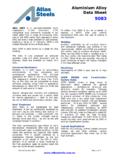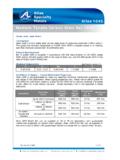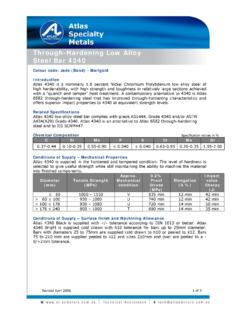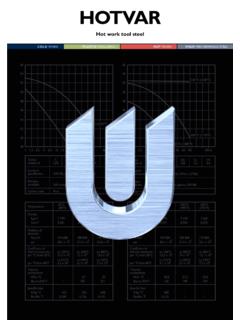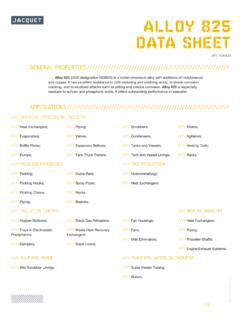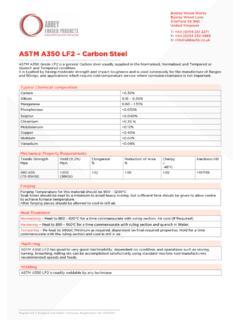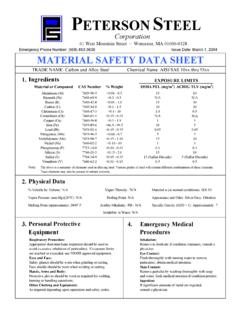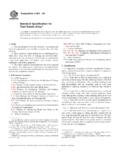Transcription of Atlas TechNotes - Cover page rev Nov 2011
1 Atlas TechNotesAtlas SteelsTechnical STEELS Technical NotesFOREWORDThis compilation of TechNotes has been produced by Atlas Steels Technical Department as acompanion to the Atlas Technical Handbook of Stainless Steels and the Atlas GradeDatasheets. Any suggestions for improvements, additions or corrections would be verywelcome; these should be directed to:Technical Manager, Atlas SteelsTelephone +61 3 8383 9863, TechNotes are available from the Atlas Steels from any Atlas publication may be freely copied.
2 But it is requested that thesource be of LiabilityThe information contained in these documents is not an exhaustive statement of all relevant is a general guide for customers to the products and services available from Atlas Steels and norepresentation is made or warranty given in relation to this information or the products or processes by Atlas Steels Technical DepartmentMelbourne, AustraliaCopyright Atlas SteelsAtlas Sorting Tests for Stainless & Crevice Corrosion of Stainless Steels - Properties & Equivalent of Stainless , Care & Maintenance of Stainless Cycle Corrosion8.
3 "L", "H" and Standard Grades of Stainless Steel Tube for the Food Industry10. Restrictions of Hazardous Substances (RoHS)11. Magnetic Response of Stainless Steels12. Pipe Dimensions13. AtlasCR12 & AtlasCR12Ti - The 12% ChromiumFerritic Stainless Steels14. Aluminium alloys 5052 and TECH NOTENo. 1revised October 2008 QUALITATIVE SORTING TESTS FOR STEELST hese tests are intended for rapid, inexpensive and usually non-destructive and on-site sorting of grades ofstainless steel. They are particularly useful for sorting products when, for example, bars of grades 304 and303 have been accidentally stored together, or grade 304 and 316 sheet offcuts tests are extremely useful, but it is important to realise that they have limitations; they cannot sort oneheat from another of the same grade, and there is no easy way of sorting certain grades from each other.
4 Forinstance, it is not possible to readily sort 304 from 321, 316 from 316L or 304 from 304L. The Molybdenumspot test therefore indicates that a piece of steel contains Mo, but does notalone indicate 316 .. in theabsence of other knowledge the steel could be 316L, 2205 or 904L etc. It is possible to use tests incombination, so an item that is shown to contain Mo, and also to be attracted to a magnet is possibly grade2205, and unlikely to be either 316L or 904L. But is it 444 or 18-2?SOME OTHER OPTIONSThe simple tests described in this Note may assist in grade identification and product sorting.
5 Other, morecomplex tests can also be carried out; these can involve several chemical reagents, hardness tests or checkingresponse to heat treatment. Proprietary kits can be purchased to carry out some of these tests. In most cases,however, if these simple tests are not sufficient to identify the product it is best to have a full spectrometricanalysis carried out by a competent laboratory. Another option is the use of portable analysis equipment,based on spark emission or X-ray fluorescence spectroscopy. This quite sophisticated equipment is used forsome PMI (Positive Material Identification) testing wherein items are 100% checked for correct composition;this is sometimes a requirement of end users, particularly in the petrochemical or oil and gas project are other less common qualitative spot tests available.
6 A manganese spot test is available with specificrelevance in sorting 200-series Cr-Mn-(Ni)-(Cu) austenitic stainless steels from the more usual Cr-Ni 300-series grades such as 304. The 200-series steels are non-magnetic and otherwise indistinguishablefrom the 300-series, but do have reduced corrosion resistance and have considerably less value as this Tech Note is primarily aimed at sorting of stainless steels, some of the tests are also relevant tosorting carbon and low alloy steels. The sulphur spot test is equally relevant to sorting free-machining carbonsteels (eg 1214 or 12L14) from low-sulphur alternative grades (eg M1020, 1045 or 4140).
7 PREVENTIONThe need for these sorting tests can be reduced if original product identification is retained. Product tags andstickers, and stamped or stencilled Batch/Heat/Grade markings should be retained as much as possible. Allproduct distributed by Atlas Steels has this identification, in line with requirements of our ISO 9001 qualitysystem. Atlas also colour code many steel products; details of this coding system including a chart of coloursare available for download from the Atlas Steels TECH , October 2008 Page 2 of 4 Atlas ResponseWhat Can Be SortedAustenitic (both 300-Series and 200-series) stainless steels from other steels.
8 All other steels are attractedto a magnet, including all the ferritic, duplex, martensitic and precipitation hardening stainless steels. Theonly other non-magnetic steels are the austenitic 13% manganese steels (eg P8 ).MethodNote response, if any, when a permanent magnet is brought close to the & TrapsSome austenitic grades, particularly 304, are to some degree attracted to a magnet when cold worked, egby bending, forming, drawing or rolling. Stress relieving at cherry-red heat will remove this response dueto cold work, but this stress relief may sensitise the steel and should not be performed on an item whichis later to be used in a corrosive environment.
9 A full anneal is acceptable, although duplex grades have only half the amount of the magnetic ferrite phase compared to fullyferritic grades such as 430, the difference in feel of a manual test is unlikely to be enough to enablesorting duplex steels from ferritic, martensitic or precipitation hardening stainless steel castings and welds are also usually slightly magnetic due to a deliberateinclusion of a small percentage of ferrite in the austenitic deposit. The % ferrite can be measured by theamount of magnetic response, and special instruments are available for PrecautionsNo hazards associated with this testNitric Acid ReactionWhat Can Be SortedStainless steels from non-stainless a piece of the steel in strong nitric acid (20% to 50%) at room temperature, or a drop of theacid on a cleaned surface of the standard samples in the same way, ie stainless and non-stainless steel steels will quickly be attacked; a pungent brown fume is produced.
10 Stainless steelsare not affected. Compare result with samples thoroughly & TrapsGrease or similar contaminants will prevent the acid contacting the steel surface, so the surfaces shouldbe clean use detergent or an organic solvent to remove these contaminants. Surface oxide layers such asmill scale will also interfere .. these should be filed or ground off, or removed by lean stainless steels, such as AtlasCR12 and other 12%Cr grades, are not totally immune from nitricacid attack. They can show some minor reaction, but much less violently than on a carbon or low the product being tested is not stainless steel there is likely to be significant attack and hence asignificant change in appearance.
